Letters from Lodi
An insightful and objective look at viticulture and winemaking from the Lodi
Appellation and the growers and vintners behind these crafts. Told from the
perspective of multi-award winning wine journalist, Randy Caparoso.
All about terroir
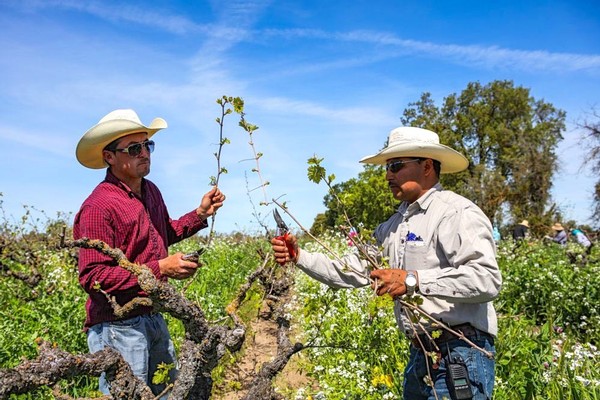
Late winter pruning of old vine Zinfandel in Clements Hills-Lodi's Stampede Vineyard (image courtesy of Gabrielle Lurie Photography)
A lot of things have been said and written about the wine term, terroir. Not all of it is good.
Just a few years ago a U.C. Davis Professor of Viticulture published a book called Terroir and Other Myths of Winegrowing (University of California Press). In the book, the professor stated outright that terroir is a crock essentially because “minerals derived from rocks may represent a relatively small part of the soil’s impact on plants,” and “mineral nutrients have no established contribution to flavor” in wines. Because of that, he concludes, terroir is nothing more than a “shibboleth that establishes an in-group in a world unto itself... This isn’t wine appreciation… it is more like wine snobbery.”
These conceptions of the term, however, are actually gross misinterpretations of what the French actually mean when they use it. The plainest definitions of terroir are probably the best because the word is far less convoluted than assumed. In a Food & Wine magazine interview published in January 2018, the famous Berkeley-based wine importer Kermit Lynch may have given the best explanation.
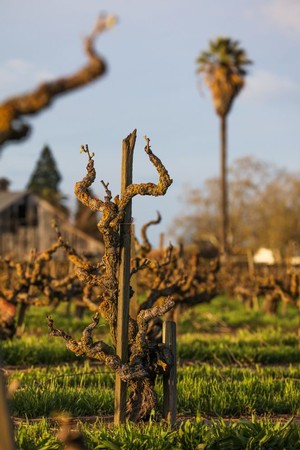
Marian's Vineyard Zinfandel, Mokelumne River-Lodi, originally planted in 1901 (image courtesy of Gabrielle Lurie Photography)
Quoting Lynch in that article:
No matter where you’re tasting, wine is influenced by the soil it grows in. It’s so easy to say that, but a lot of Californians won’t admit it. I’ve had a lot of well-known — one really well-known — California winemakers tell me that terroir is simply propaganda, that it’s just a marketing device from the French. But when you really get into wine, you find that no, if you plant a vine at Romanée-Conti [a prestigious vineyard in Burgundy, France], a Pinot noir wine and you take exactly the same Pinot noir vine clone, and plant it in a salt marsh, you’re going to have two different wines. That proves, as exaggerated as that is, that terroir matters.
You can go into Romanée-Conti and taste Pinot noirs from several vineyards, and people who know their wines well can go in, taste a 10-year-old wine and say “That’s La Tache”. It’s just next door to Romanée-Conti. Not Romanée-Conti, but some can identify it because it possesses qualities that can be identified by tasting.
You add so much interest to wine when you’re talking about terroir instead of a varietal flavor. To me, that whole culture in Italy and France — you get it in Germany too, and Spain — it just added so much interest for me, about wine. And that’s why I talked about it so much because it seemed true to me. Wendell Berry once came through Berkeley several years ago, and he shocked me because he told me that my book Adventures on the Wine Route was one of the best books he’d ever read on agriculture. I was like “Really? What?”. And he said “No, you talk about the source of and the quality that you find in the wine, and it comes from a specific place and a specific person, and the result is influenced by all these factors.” I’d never thought of my book in quite that way.
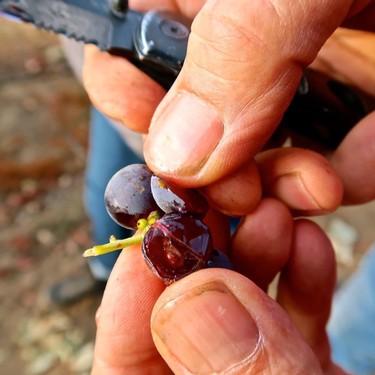
Examining Lodi's ancient vine Zinfandel berry during harvest
In the same vein, the plainest way that I can put it is this: Terroir is a French term that entails natural environmental factors, such as climate, soil, topography, aspect, elevation, latitude, etc., that have a direct effect on grape qualities, and ultimately on wines. But because vineyards, like wines, involve human input, viticultural traditions typical of regions or eras are often considered part of a region's or vineyard's terroir.
The word is also frequently applied to sensory qualities in resulting wines in terms of their expression of "sense of place," especially when there is less priority placed on qualities such as varietal character (i.e., the taste of a grape variety), a producer's choice of brand style, or the distinct taste of a winemaker's favorite oak barrels.
On a sensory level, however, it is important to remember that a wine's expression of terroir is not necessarily, as the word implies, an earth- or mineral-related quality, although earthy or mineral qualities can certainly be part of it.
More often, terroir-related distinctions are expressed through the aromatic and structural profiles of wines. Lodi-grown Zinfandels, for instance, are known for their fragrant, red fruit qualities, typically suggesting cherry, often with black tea-like nuances, whereas Zinfandels grown in heritage vineyards in Sonoma County or Napa Valley have less floral yet deeper aromatic profiles, often suggesting darker fruits like blackberry or plum mixed with red berries.
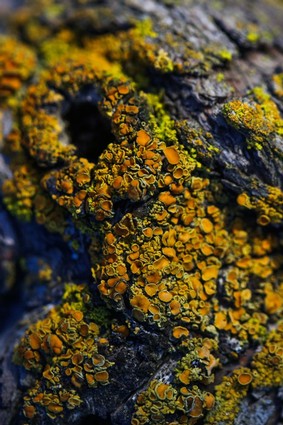
Electrical color of winter lichen on Lodi ancient vine (image courtesy of Gabrielle Lurie Photography)
Lodi Zinfandels are also generally softer in tannin, and Sonoma and Napa Zinfandels are firmer and grippier. These distinctions are the direct result of differences in terroir. North Coast Zinfandels are typically grown in shallower, rockier, often hillside soils in addition to climates with more pronounced diurnal temperature swings, as opposed to Lodi Zinfandels grown in extremely deep, sandy soils on flat terrain, in a slightly warmer climate with slightly more moderate diurnal swings.
You can take it further by comparing terroir-related characteristics of Zinfandels grown on the west side vs. the east side of the City of Lodi. West-side Lodi Zinfandels are typically earthier, tinged by notes suggesting some kind of loaminess, whereas east-side Lodi Zinfandels tend to be more floral and red fruit-focused, with almost no earth tones. As far as anyone can tell, these are direct results of minute differences in the sandy loam compositions of the soils, since there are almost no climatic or temperature differentiations during any given year's growing season on either side.
Old-timers in the Lodi wine industry have known these differences forever. They may not use fancy-schmancy words like terroir, but their knowledge of this phenomenon constitutes the same concept. It is not something anyone plans for. They don't farm for it. A distinctive "sense of place" simply happens because wines are made from grapes, and grapes respond differently to different environments.
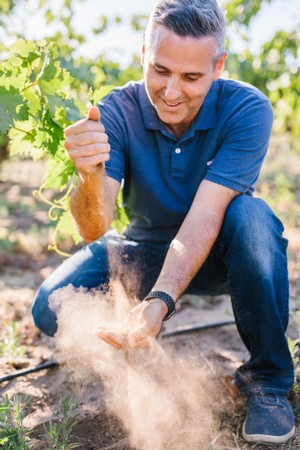
Stampede Vineyard co-owner/grower Jeff Perlegos with fine sandy loam in his Mokelumne River-side ancient vine planting
It follows, as it were, that sensory qualities expressing terroir are usually associated with wines made with minimal intervention, since the less you do to a wine the more likely you are to end up with natural qualities influenced by environmental factors. Typically, this style of winemaking involves the use of native yeast for fermentation; no use of enzymes, acidulation, or wood amendments; or aging in older, neutral barrels, following protocols, for example, in Lodi-grown wines bottled under the Lodi Native label. Or wines may be made in a "natural" style (another unregulated term) less likely to obscure subtleties reflecting grape sources.
Focus on terroir, if anything, has proven very useful for many Lodi-based producers as a way of demonstrating vineyard-related characteristics unique to the region, thereby helping to better define and thus increase a conscious appreciation of qualities that define "Lodi." After all, why should anyone buy a wine that says Lodi on the label if it tastes exactly the same as a wine that came from, say, nearby Amador County, Paso Robles, or (heaven forbid), Napa Valley or Sonoma County? In today's market, where values like authenticity have become commercial prerequisites, it's more important than ever that a wine grown in Lodi tastes like it comes from Lodi, and the same for wines from Napa Valley, Paso Robles, Burgundy in France or Rías Baixas in Spain.
Years earlier (in 2001), I had my own conversation with Kermit Lynch over dinner in San Francisco (a rare occasion, since Lynch has an aversion to crossing over the Bay Bridge from Berkeley, where he lives six months out of every year, the rest of the time in France), when the subject of terroir came up while we were enjoying an extremely light yet beautiful red wine from an obscure, unheralded little vineyard called La Pièce Sous le Bois.
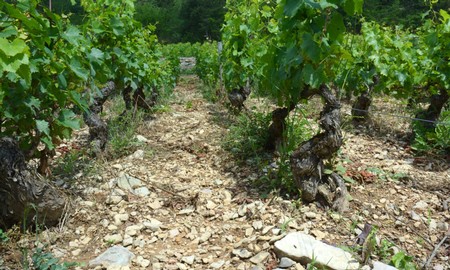
La Pièce Sous le Bois (image courtesy of beckywasserman.com)
A related topic actually came up earlier in the evening during a discussion of a book that we found we both had enjoyed, called Fast Food Nation by Eric Schlosser. Said Lynch, "The book talks about the chemicals and artificial flavors they are putting into our food, making us think that we are eating something good when in reality we may be eating ourselves to death. They're now doing that to our wine!"
Like fast food, said Lynch, modern-day winemaking has become all about "pop." Said Lynch, "Big companies, and even small farmers and winemakers, are asking, 'What kind of wine is popular today?' And so they manipulate the vineyards, select yeasts, enzymes, wood products and even add chemicals to the wines to make that kind of wine. In the future, they're going to be able to add a chemical called the 'Romanée-Conti' to flavor wine. Who cares about what wine is best for a particular vineyard site? Nowadays it's all about uniformity, or else flavor descriptions like 'power' and 'explosive.' Somehow, Rambo has taken over the wine world."
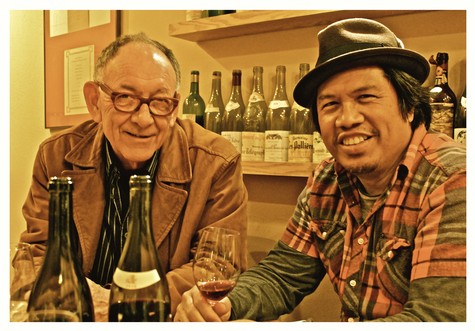
The author with Kermit Lynch, in pre-COVID times
And so while we were sipping the La Pièce Sous le Bois, Lynch pondered further: "It goes back to what I was saying, that wines should taste like where they come from. La pièce sous le bois means a 'little parcel under the woods," and it is certainly little, but full of finesse and harmony. It expresses its terroir — a word that many wine writers misinterpret. To the French, the taste of terroir is not 'of the soil.' Soil is just a small part of terroir. It is also the angle to the sun, the rainfall, the climate, the little breeze that tends to blow in from the next valley, and not in the least, the viticultural and winemaking traditions long associated with that particular region — everything that contributes to the character of a wine.
"You can change the way a wine is grown and vinified, but when you do that you change a wine's terroir. That's the problem with most wines of the world and even in France these days. Everyone wants to turn wines into something they are not."
So here's to enjoying Lodi wines for what they are, not what anyone thinks they should be!
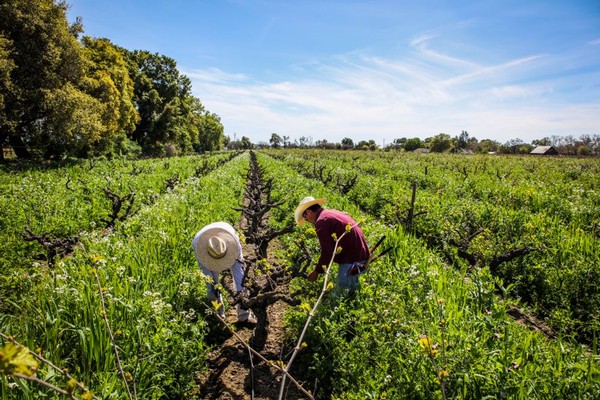
Late winter pruning in Clements Hills-Lodi's Stampede Vineyard (image courtesy of Gabrielle Lurie Photography)